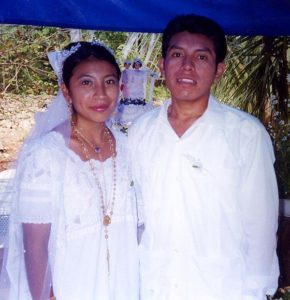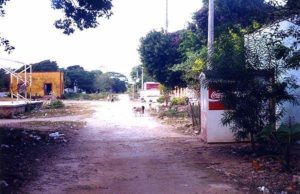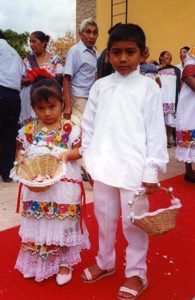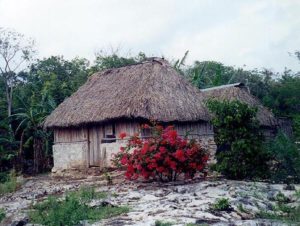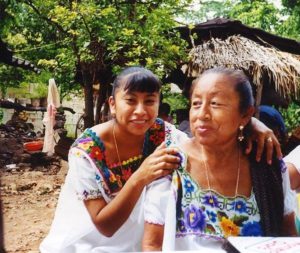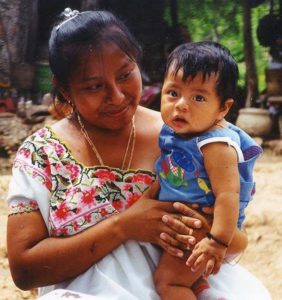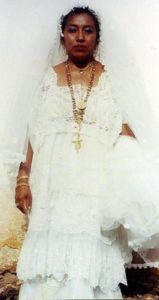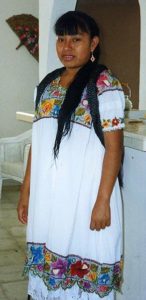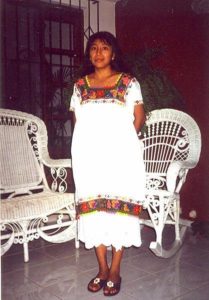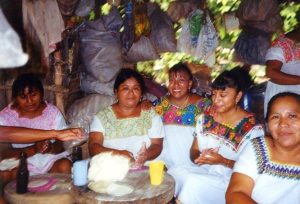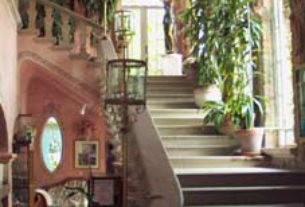The majority of people who visit the Yucatán Peninsula of Mexico will visit Cancún, Cozumel or Mérida. All these places have an established tourist infrastructure, are modern and contain every convenience necessary for tourism. However, in close proximity to these well known tourist destinations, exist the villages of Yucatán. In the villages there is almost no tourism, few modern conveniences and day to day village life does not differ much than it did one hundred years ago. Timucuy is one of these villages.
The Setting
The municipality of Timucuy (tee-moo-KUY) is located in the Northern part of Mexico’s Yucatán Peninsula. The name in Maya means the “place of the turtledove.” It is approximately 30 miles south and east of Mérida, the capital of the Mexican state of Yucatán. To the north are the municipalities of Kanasín and Acanceh. To the south, is the municipality of Tecoh, to the east, Acanceh and to the west, Umán. Before the Spanish Conquest and the founding of Mérida in 1524, the site was part of the Maya Chakán Province. After the Conquest, it was part of a land grant granted by the King of Spain to an individual or family. Around the time of the henequen boom (1890-1920), the village grew around the large henequen haciendas that were prevalent throughout the area.
The population of Timucuy is just over five thousand people. Of the five thousand, it is estimated that slightly over two thousand one hundred inhabitants are “economically active” or are employed or provide economic aid to the family unit (Enciclopedia). Principal crops are corn, tropical fruits and beans. Corn is the staple and is used on a daily basis in all homes. Tortillas, bread and even some beverages contain a corn base. A corn patch for harvesting is part of almost every home. Livestock is present both in and around the village and in homes. There are slightly over one thousand houses, mainly thatched roof huts constructed of block and/or wood. 19.7 % of the houses have dirt floors. Houses with floors are usually constructed of block and have floors of concrete with an occasional tile floor found. 93.2% of all dwellings in the village do not have a drainage method or sewers for water and human waste to escape the proximity. No outhouses exist and bodily functions are done outside in close proximity to the house. Most houses have electricity with only 4.4% not having electricity available (Inegi).
The principal buildings around the town plaza consist of the church, La Iglesia de San Gaspar, constructed in the colonial period (16th century), the municipal center, various small shops and markets. There are four primary schools (grade schools) and three secondary schools (junior highs) in Timucuy.
There is a small medical clinic staffed by a resident doctor and nurse. At the end of medical and nursing school, the doctors and nurses must serve for a period of one year in a small village such as Timucuy. They usually live at the clinic and can go to their hometowns on weekends or on days off. At the end of the one year’s service, the doctor can go on to specialize or enter into private practice. And, after one year’s service in a village, the doctor’s medical school expenses are considered paid and he has no more obligation to the state. The clinic at Timucuy is staffed by this arrangement.
Curanderismo
Residents have another form of medical treatment available. Curanderismo is the art of folk healing by using non-traditional methods. The curanderos treatment may consist of remedies, magic, potions or herbs depending on what the illness is. Curanderos may be of either sex, but male healers are respected more. One gets to be a curandero by serving as an apprentice or by being seen to possess the gift of God for healing. They enjoy a special position in the community and are seen to fill voids left by medicine and religion. There are three respected curanderos in Timucuy. Rates charged depend on the social status of the family and vary for services rendered and severity and nature of the illness. Sometimes food or animals are used as a form of payment in lieu of cash. Many inhabitants will consult the curandero before the doctor. Others will consult after seeing the regular doctor and failing to get results from traditional methods. These healers are seen as the only medical or religious persons who may treat a case of spell casting known as brujería. The curandero is never involved in child birth.
The Inhabitants
Timucuy is composed mainly of indigenous and mestizo population. The Maya huipil (white embroidered dress with multi- colored top) is commonly worn in the home and in the street. Most women have several huipiles and they wear them daily. One is usually more elegant and is worn to special occasions like weddings and quinceañeras. Men will wear traditional dress of white shirt, white pants and straw hat only on formal occasions. Sandals are the preferred footwear for men and women and many will go barefoot especially from March to October.
Maya is commonly spoken between the inhabitants and most children continue to study the Maya language in school. Although Spanish is the official language, Timucuy falls into the category of being one of the villages in the state of Yucatán where 30 or more percent of the village is Maya speaking. 29.7 % of the population above the age of fifteen cannot read nor write. 44.3 % of the population above the age of 15 has not finished primary school and 10.6% of inhabitants are monolingual and speak only Maya.
65.7% of village dwellers do not have form of economic health assistance and must bear all expenses of sickness, accidents, medicine or birth expenses (Inegi). Health insurance is almost non-existent in the village and the only people to have economic assistance are those who fall under social security, retired military or government workers.
The Physical and Psychological
Village inhabitants tend to be short. The average height of the male is around five feet and the average height of the female is just short of five feet. Males and females are generally thick bodied with long arms and small hands and feet. The frontal part of the head is broad. People are usually free of dental decay until after age 20. A lower pulse rate is common and straight hair is the rule. The epicanthic eye fold, a small fold of skin covering the inner corner of the eye, is present in some cases and is a characteristic shared with inhabitants of people of Siberia, giving validity to the theory that the migration came from this area, crossing the Bering Strait and working south to eventually settle in Mexico, Central and South America. In West Texas, less than 1% of babies are born with the epicanthic fold (Flood-Shaffer).
Many babies in the village are born with the Mongolian spot at the base of the spine. The Mongolian spot is a blue to gray area of skin usually found on the lower back or buttocks area at birth. This spot usually disappears before 10 years of age. In our area, the Mongolian spot is present in 10 to 15 percent of births and is much more common in Black and Hispanic babies (Flood-Shaffer). In babies of Asian descent in this area, the incidence runs as high as 80 percent (Patel). In the Mexican state of Yucatán, the majority of babies are born with the Mongolian spot (Reyes).
In Timucuy, as well as all villages in the region, there is a high infant mortality rate. Infant mortality rate is defined as the number of deaths for every one thousand live births. In the United States the infant mortality rate is 6.76 deaths for every thousand births. In Mexico it is considerably higher at 25.36 (World). In Timucuy the rate is higher due to isolation, transportation problems, lack of potable water, economic factors, insufficient medical care and reluctance to go to the “white” hospitals located in Mérida.
Many inhabitants of Timucuy have gold and silver teeth, especially in the front upper teeth. This practice is usually done during the teen years. The ancient Maya practiced both cranial and dental deformation and jade was used in ancient times as an inset in front teeth to enhance beauty. We can assume due to the value placed on jade that only the aristocratic class used jade for dental insets. Perhaps the lower classes used less expensive metals to achieve the same aesthetic result. Also, in ancient times, scarring, tattoos and crossed eyes were seen as beauty traits. Scars were re-infected time after time to achieve maximum visual effects and were popular in the warrior class. Today there is little evidence of these ancient practices except for gold and silver frontal teeth.
The people of Timucuy are clean with the daily bath a ritual in most families. The homes by our standards are seen as untidy with animals in close proximity to living quarters. The inhabitants are generally conservative and are seen to be happy, sociable and friendly. Families and individuals are independent. There is a non-competitive nature present and a general respect for the law. In many cases resentment exists and grudges between families or individuals are carried for years. People are generally honest. Even among the poorest families, there is little or no begging. Almost everyone is superstitious and to some extent fatalistic. Bad dreams are seen as bad omens and certain days are seen as lucky and other days unlucky. The number 13 is considered lucky, because in Maya mythology there were 13 gods in the upper world.
Compadrazco
Compadrazco can be defined as co-parenthood. It always involves religious rites of the Roman Catholic Church and is seen as a way to amplify the extended family system and create bonds between persons who may or may not be blood related. It is practiced by Latino cultures worldwide and the village of Timucuy is no exception. In religious activities such as baptisms and first communions, the parents will choose a couple to serve as godparents to the child during the ceremony. The chosen couple can be relatives or non-relatives, and in some cases the employer and his wife may be asked by the employee to serve in the role as compadres.
When the couple accepts they will attend the religious event and there is a ceremony when the priest formally recognizes the godparents. The priest has the authority to reject the godparents and may choose to do so if one or the other are not Catholic or has been married before. This can vary from priest to priest. This binding between families lasts for life even if there is disagreement between the families. From the point of becoming compadres, the relationship is much stronger and even the forms of addressing each other changes. Compadre, (godfather) comadre (godmother) are used between adult co-parents. Ahijado (godson), ahihada (goddaughter), padrino (godfather) and padrina (godmother) are used between the child and the godparents.
This system usually involves some sort of a financial commitment and godparents are expected to make sure the child’s religious training is completed in the event of death of the parents. It is considered in bad taste to forget the birthday and other holidays for families involved in compadrazco. The village of Timucuy thrives on this system and many new bonds are formed each year by the compadrazco system.
The Beginning
The double last name system of a paternal last name and maternal last name is always used when a child is born. For example, the name Juan Miguel Chan Yuc. Juan is the first name and Miguel is the middle name. Chan is the paternal last name and Yuc was the paternal last name of the mother before marriage, or the mother’s maiden name. Let us suppose that Juan Miguel Chan Úc marries Asunción María Puch Yam. The first male child was born and is named José Carlos. The entire official name would be José Carlos Chan Puch. The difference between our name system and the naming system used in the village and Latin America is that the mother’s maiden name is always included. Hence, families can trace their ancestors back on both sides of the family. In society sections of city newspapers, the names sometimes contain as many as 10 maternal and paternal names to show readers who were grandparents and great grandparents. In the villages, the four name system is commonly used. In stark contrast to common paternal last names used in the cities such as Sánchez, Gonzales, Morales, Cáceres and Alpuche, some common paternal last names in Timucuy are Úc, Chan, Puch, Dzul and Pech.
There are several midwives in the community. These women are called comadronas and are found in all villages and haciendas where there is no or little medical service. Their fee depends on the economic stature of the family. Many births take place at home. The well-off of Timucuy are able to afford to go to the capital an hour away and receive hospital and medical treatment for births.
Love Is In the Air
In the village, a courtship of five years is not uncommon before marrying. The courtship process is much more formal and the male must obtain permission from the girl’s parents before beginning to “date.” Much more control is placed on the couple and chaperones almost always accompany the couple. Un-chaperoned dating is looked down upon and could be grounds for a scandal. When the couple decides to marry, the groom must ask formal permission from the parents of the bride. The permission is almost always given because, if the groom were not acceptable, the family would have found a way to discourage the relationship at a much earlier date. After marriage it is common for the couple to live with either the bride or groom’s parents, sometimes for a number of years, until the couple can afford to construct their own thatched roof hut.
In Mexico there are many times two marriages, one in the church performed by a priest and the civil ceremony which takes place in the office of the Civil Registry. The only one that is seen as legal is the civil marriage. The religious ceremony is a luxury practiced only by those with economic ability.
“I Do”
When a religious ceremony takes place, it must be planned well in advance so the priest may officiate. The one priest of Timucuy serves other villages in the vicinity and, with all the other religious ceremonies that take place, is a very busy person. As in the case of the quinceañera, the hosting family may go into debt for many years to be able to pay for the wedding and expenses. The family of the groom and the family of the bride split expenses depending on economic status.
Both bride and groom usually walk to the church from their houses as do the majority of people who attend the wedding. Private cars are rare in Timucuy. The bride generally wears an all white embroidered dress, styled in the same fashion as the huipil. The bridesmaids usually wear matching dressy huipiles with the many colored embroidered top. The groom will wear the traditional white long sleeved shirt and matching white trousers. Music to accompany the wedding in the church is provided by three to four guitars provided by friends or compadres. The religious ceremony lasts between forty-five minutes and an hour. The civil ceremony is usually done several days before the religious wedding and lasts about fifteen minutes.
Once finished, the couple will walk to a private home for the reception. The reception may be hosted by a friend, family member or compadre. The patio is of dirt and host and guests must share space with livestock and chickens of the hosting family. There are plastic chairs and tables for the guest’s comfort, commonly borrowed from businesses. There may be live music or piped music. Compadres and friends share duties of hosting the reception and many huipil dressed women are hard at work preparing corn tortillas, the staple of any reception or social event. There is usually a bottle of rum on each table to be replaced when empty and friends of the bride and groom act as waiters serving beer to the guests. After the traditional waltz by the bride and groom, the guests are encouraged to participate. The reception will last late into the night until all liquor, beer and food are depleted. Village inhabitants do not tolerate liquor well and by the end of the reception it is common to see many men passed out on the patio and in the vicinity of the reception.
The End of the Game
In Timucuy and small villages in Yucatán there are no funeral homes. When there is a death in the family the burial takes place within 24 hours because embalming is not practiced. There are no facilities in Timucuy for embalming and it simply is not the custom. The deceased is bathed and dressed by family members and in some cases compadres. The corpse is displayed in the home for around 6 to 12 hours before burial. During this time, friends, extended family members and compadres will come by the home of the deceased to pay respects to the family. Food and in many cases liquor are brought and consumed during the visits. If the deceased has died during the afternoon or evening, the burial will not be until the following day. Family members always remain close to the corpse during the night. The burial will be with or without a priest. Priests usually live in larger villages or cities and cannot get to the village given the time constraints. A simple wood coffin is used for burial. Eight days after the death there is a special mass given for family members and friends called an ochavario. Another mass is given on the date of the death for each succeeding month during the year. After the first year a mass is given on the date of the death each year.
The community cemetery is a short walk from the center of town. When a death occurs, the family and friends will make the walk from the home of the deceased to the cemetery. The coffin is carried by family members or friends to be interred. In sharp contrast to our system, the burial site is not permanent. After a number of years, the deceased’s remains are taken away and another person’s remains are placed in the space. Graves are marked with a simple cross bearing pertinent information such as date of birth and death.
Some changes have come to Timucuy. There is bus service each day to Mérida. Bicycles are common and serve as taxis. Women now carry their corn for tortillas in plastic containers instead of earthen pots. Canned foods and soft drinks are available in the small shops. Some young women now have abandoned the traditional huipil for jeans and tops. There is medical service available in the village. With each passing year, one hears more Spanish spoken and less Maya.
On the other hand, many aspects of village life have remained unchanged. Men still die from snakebites. A high infant mortality rate exists in spite of available medical service. A bath tub or toilet is rare. Cooking is done over an open fire with firewood as the principal source. Corn remains the staple diet. There are no tractors or lawnmowers. Planting is still done using the ancient method of a stick to plant each corn seed. Timucuy is a mix of the modern and the ancient culturally, socially and in the secular and ecclesiastical sense. With time, how many more changes will occur in Timucuy with the increase of tourism in the region?
Works Cited
- “Enciclopedia Yucatán en el Tiempo.” 29 January 2003. https://www.e-local.gob.mx/enciclo/yucatan/municipios/31090a.htm.
- Flood-Shaffer, Kellie, M. D. Texas Tech University Health Sciences Center. Personal interview. 31 March 2003.
- “Inegi, X11 Censo General de Población y Vivienda, 2000 INI. Dirección de Investigación y Promoción Cultural, IBAI. Base de Localidades y Comunidades Indígenas.” 12 Feb. 2003.
https://www.ini.gob.mx/indica2000/mpo/yuc85.htm. - “Infant Mortality Rate” The World Fact Book. 2001. 1 April 2003.
- Patel, Neal, M. D. Texas Tech University Health Services Center. Personal interview. 2 March 2003.
- Reyes, De Cáceres, Carlos. Personal Interview. 6 April 2003.

